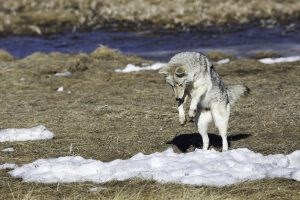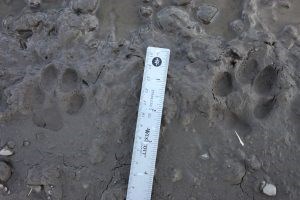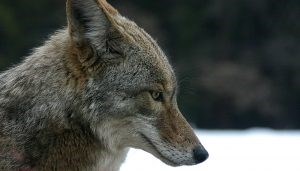This content was originally published by the Longmont Observer and is licensed under a Creative Commons license.
This will come as a surprise to some of you and not to others of you. There are coyotes living in our city. I’ve seen them. There have been reports of them on social media. When you think of coyotes, you may think of them in the country. But increasingly, there are urban populations of coyotes.
Coyotes are very adaptable animals, and they have adapted to urban environments. This adaptation is changing their behavior and even their relationship with other species with whom they normally would not coexist. Recent research shows that coyotes coexist peacefully with red foxes in urban environments. Normally, in the country, coyotes would kill any red fox they found to decrease competition for resources. But in the city, resources are plentiful.
Coyotes are about the size of a small German shepherd. They are about four feet in length and weigh 30-40 pounds. Female coyotes weigh slightly less than male coyotes. The fur ranges in color from gray to reddish-brown with a cream-colored belly. Coyotes have a full, bushy tail that is tipped in black. The ears are rusty-red in color on the back side.

Coyotes occur pretty much wherever food is abundant, which includes the city. They usually maintain territories called home ranges. Home ranges can vary in size from two square miles up to 20 square miles. The size of the home range usually depends on the amount of food and cover that is available. Home ranges are smaller in the city where food tends to be quite abundant. Male coyotes usually have slightly larger territories than females. A home range may be inhabited by a single coyote, a pair of coyotes, or a family of coyotes. Coyotes use brush for cover and for resting during the day and also use dens when weather is severe and for raising young.
Coyotes are omnivorous which means they eat just about anything. They are opportunistic and will take advantage of food sources that are readily available. However, about 90% of their diet is meat-based and only about 10% is vegetable-based. Rabbits, rodents, and carrion make up a large portion of their diet. Coyotes also eat insects, berries, and watermelon. They are also known to prey on pets and rummage through garbage for food. Coyotes hunt in open to semi-open areas and are most active at dawn and dusk. They are capable of running up to 40 miles per hour.

Coyotes are capable of breeding when they are one year of age, although many do not breed until they are two years of age. Female coyotes go into heat once a year between January and March, although courtship may occur two to three months before that. Estrus (the time when the female is in heat) only lasts two to five days. Although some coyotes may mate with each other for several years, they generally don’t mate for life.
The pregnant female builds a den by burrowing into a hillside or a bank. Often, the female will build a second burrow in case the first burrow is disturbed. Burrows range in size from a few feet deep to 50 feet and may have more than one entrance. Gestation lasts about nine weeks (60-63 days). A litter of coyotes ranges from 1-13 pups with the average litter size being 5-7 pups.
Coyote pups are born with their eyes closed and weigh about nine ounces. Occasionally, siblings from the previous year will help to care for the young. While the mother is nursing, the male brings food to the den. Pups emerge from the den at two to three weeks of age. At about three weeks of age, the pups begin to eat solid food. By the time they are seven weeks of age, the pups are weaned.
Play behavior in the pups serves to help them learn social interactions and eventually helps determine their social position. At six to nine months of age, the pups will begin to disperse. In some cases, the pups will stay with their parents until the second year.

As mentioned, urban coyotes have been known to prey on pets and also livestock. There are nonlethal methods that are effective for reducing predation on livestock, but I will deal with learning to live with urban coyotes. Coyotes can climb over fences, so it is a good idea to keep your pets indoors and only let them out when you are present. Don’t leave your pets outside after dark.
Coyotes can be deterred from climbing by installing six-foot privacy fences. Build a fully enclosed kennel if you have to keep your pet outside. Keep pets on a short leash when outside, or if they are in your yard, stay close by. Use extra caution during dawn and dusk. When walking your dog, don’t allow them to play or interact with coyotes. Avoid areas with thick vegetation or potential den sites. If a coyote approaches while you are out walking your dog, pick the dog up if it is small.
It is also a good idea to not feed your pets outside. If you do feed them outside, leave the food out for only one hour and then bring it inside. Most importantly, never feed coyotes! If they become accustomed to being fed, they may become aggressive. Be sure to remove fallen fruit from the ground and bag food waste. Place trash in containers with tight fitting lids. Because water sources can attract coyotes as well, it is best to remove them from your yard.

If you run into a coyote while you are out walking, don’t run. Stand tall and yell and wave your arms. You can also haze coyotes by banging pots together, blowing a whistle or horn, stomping your feet, and using a water hose or pepper spray. You can throw tennis balls or rocks. If the coyote approaches you, back away slowly and if attacked, fight back. If you are concerned about encountering a coyote, plan your activities for daytime. Walk with a walking stick and carry things to throw or a deterrent spray such as pepper spray. Should you run into an aggressive coyote, report it to the Colorado Division of Parks and Wildlife at 303-297-1192 or by email.
Humans and coyotes can coexist if proper precautions are taken. They are beautiful animals that can be amazing to observe. Now that they are present in our city, do your part to live responsibly with them and enjoy them at the same time. You may hear rather than see them. Enjoy these smart animals that Native Americans refer to as God’s dog.


